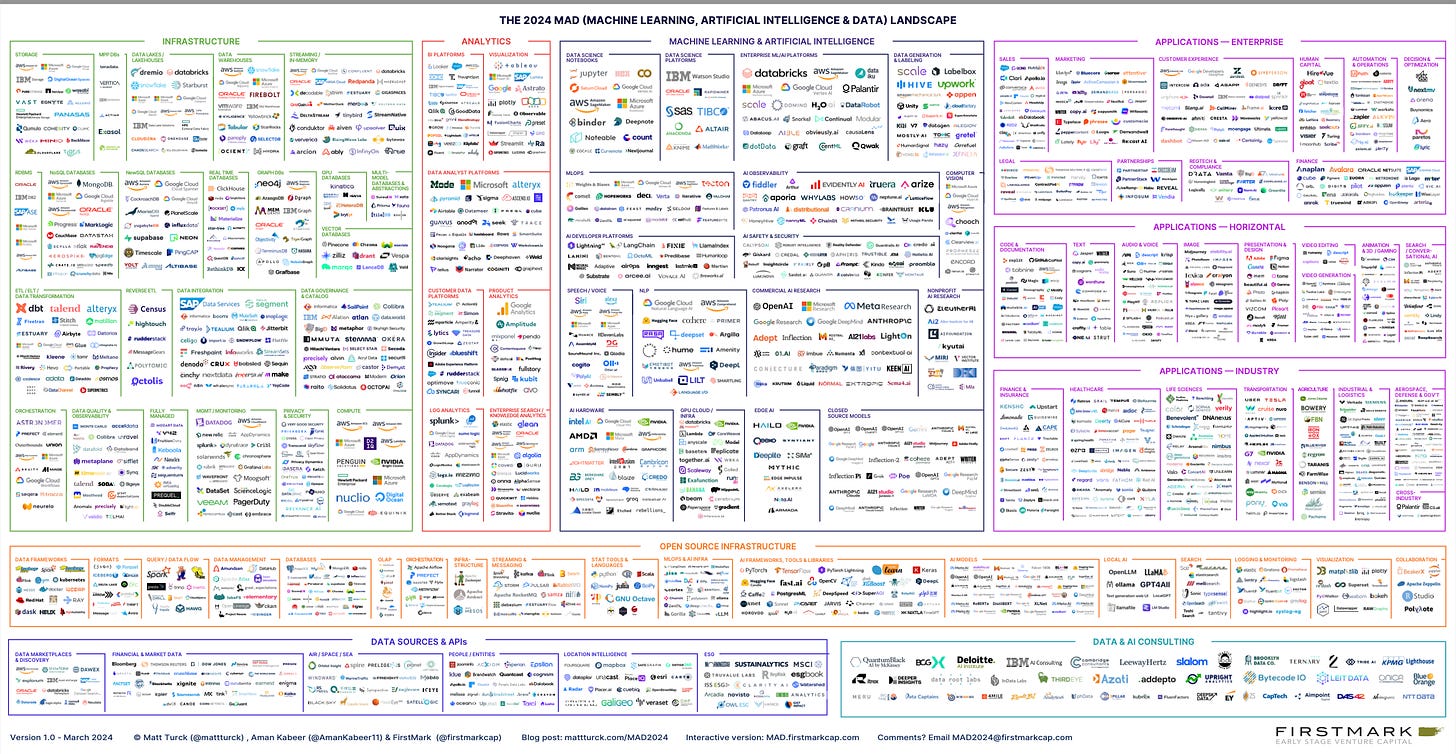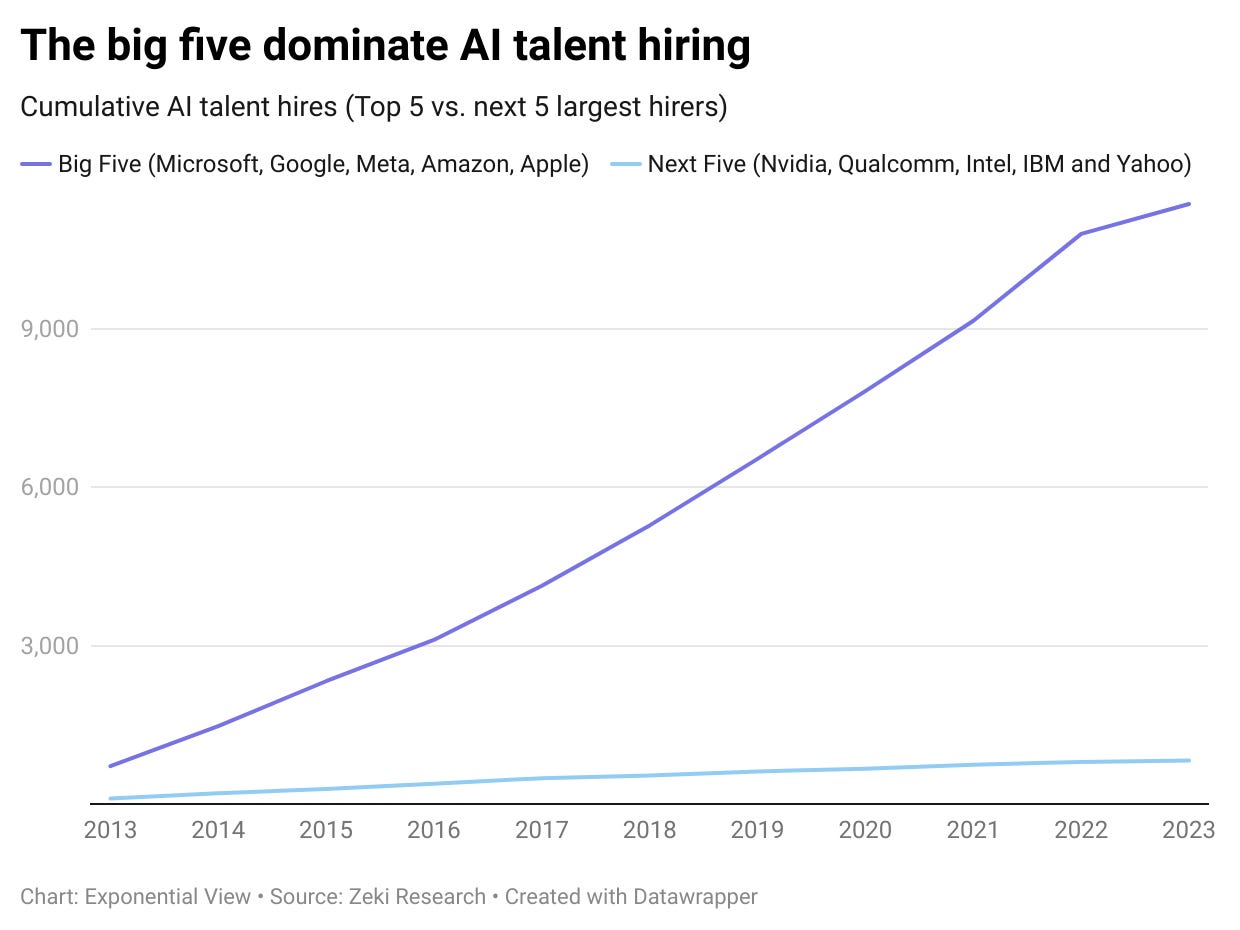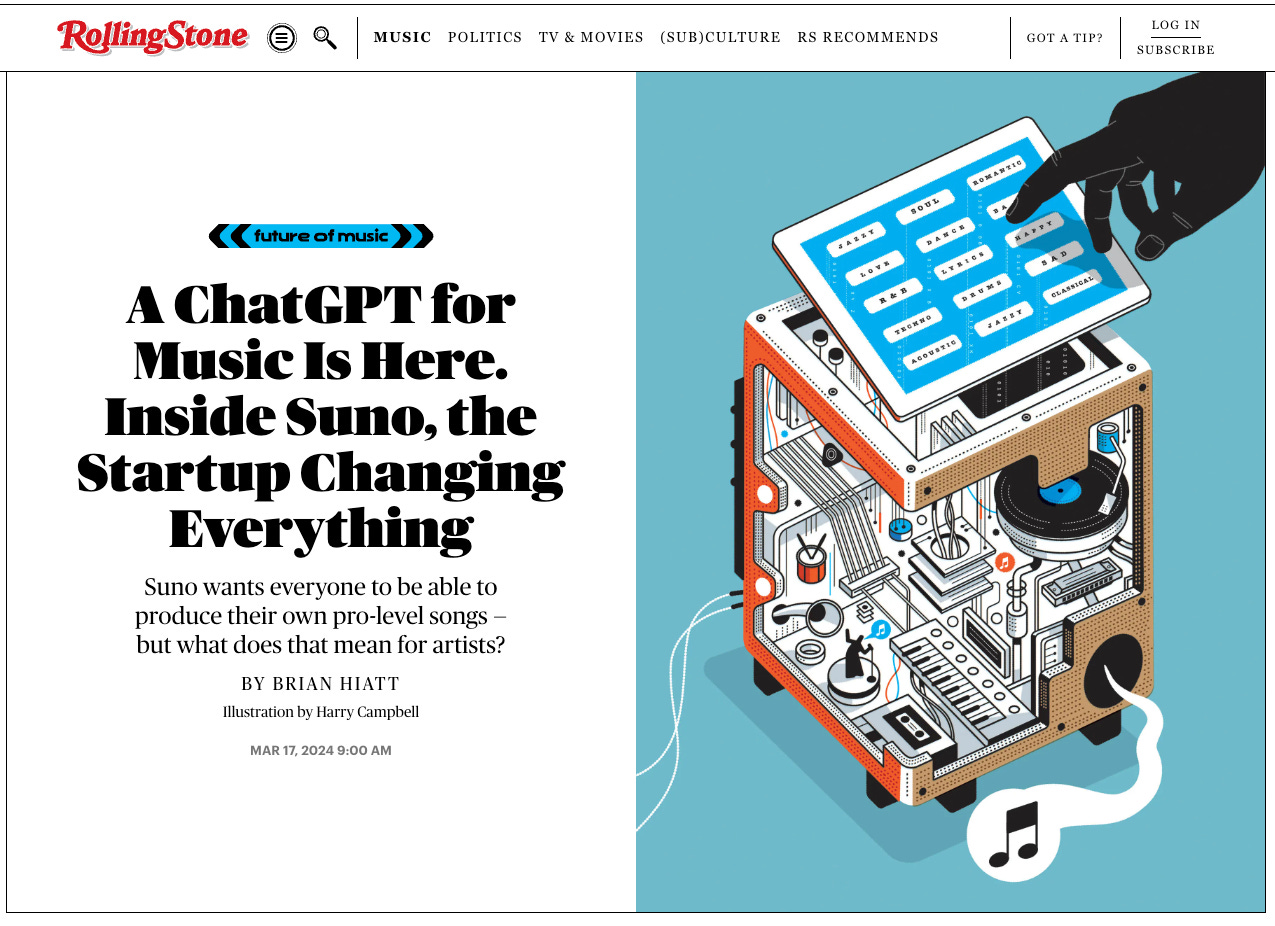#9 AI Talent War
Plus: FirstMark's 10th AI/ML Market Map, Databricks' Ascend, Suno AI, and More
👋 Welcome back to "AI Simplified for Leaders," your weekly digest aimed at making sense of artificial intelligence for business leaders, board members, and investors. I invite you to explore the past issues here.
In this issue, I cover:
Notable AI News and a Spotlight on Databricks
The Maddening Data/AI Market Map and Great Insights From FirstMark
AI Talent War
What Leaders Should Do (or Not Do) in AI Talent Strategy
Suno AI: a popular AI app to turn your text prompts into pro-level songs
Enjoy.
AI News, Curated for You
1. US and UK Signed Landmark Agreement on AI Safety
The agreement lays out how a partnership will independently evaluate private AI models and access risks on AI safety. OpenAI, Google DeepMind, Microsoft and Meta have signed voluntary commitments to open up their latest AI models for review.
2. Google Considers Charging for AI Search (the “Perplexity” Model)
Financial Times reports Google takes moves to create AI-powered search results behind the paywall, which to me sounds like the Perplexity model except that the underlying AI model will stay Germini only. It is unclear when the top management will approve the launch, as the impact on Google’s $175bn ad business revenue has to be carefully considered.
3. Sequoia Capital’s AI Ascent 2024
Sequoia Capital hosted its AI Ascent event in 2024. Speakers included Sam Altman of OpenAI, Dylan Field of Figma, Alfred Mensch of Mistral, Daniela Amodei of Anthropic, Andrew Ng of AI Fund, CJ Desai of ServiceNow and (currently) independent researcher Andrej Karpathy. The talks ranged from the merits of large and small models, the rise of reasoning agents, the future of compute and the evolving AI ecosystem. Some of the videos are on the AI Ascent 2024 YouTube playlist.
Some Thoughts on Databricks’ Ascend
Databricks released the best-in-class open-source AI model DBRX and launched an all-out media campaign about the release last week. The model took months and $10 million in training. In the WIRED article that talks about the creation of this AI model, Databricks’ leaders emphasized that the data fed into the model over the final weeks of training made a big difference to the end result. Where the data comes from and how special the data quality is are not disclosed.
As we probably all know by now, the 'best-in-class’ AI models usually have only a brief time taking that claim before the next ‘best-in-class’ AI model released by OpenAI, Google, Meta, Mixtral or others. And the WIRED feature story reads more like a showcase of the data-centric philosophy and AI model talent at Databricks (Is the MosaicML acquisition last year also turning into a talent acquisition?) instead of the model itself.
Over my investment career, I have analyzed more than 100 companies going through the IPO process and observed how they attempt to crystallize and enhance their core value proposition in the 1-2 years leading up to the IPO. I thought I had seen it all, yet Databricks continues to surprise me with the pace, scale, and success of its impressive and comprehensive pre-IPO developments:
Addressable market reframe: Databricks has shifted its positioning from a data infrastructure layer player to a comprehensive data and AI solution provider. This strategic reframing allows the company to break away from the conventional data infrastructure peer group and enter a bigger league for valuation comparisons.
Thoughtful marketing and PR wave: Having followed Databricks for over 5 years, I cannot recall a time when the company's marketing message was as coherent and impactful as it has been recently. The company has made significant strides in effectively communicating its value proposition to the market.
Active and visible ecosystem investments: Databricks has been astute in accepting investments from key AI leaders while also investing (albeit in undisclosed amounts) in high-profile AI startups and alliances. This strategy is particularly clever considering the company's own need for capital.
Strategic flex of technological capabilities in the context of a client-centric mindset: The recent launch of Databricks' best-in-class open-source model, accompanied by PR articles and interviews in major media outlets, showcases not only the company's technical capabilities but also its positioning as an enabler of enterprise clients' last-mile AI needs.
Databricks' pre-IPO journey has been marked by a series of well-orchestrated moves that have significantly enhanced its market positioning, visibility, and perceived value. As the company continues to execute its strategy, it will be fascinating to observe how these developments translate into its IPO performance and long-term success in the rapidly evolving data and AI landscape.
The Maddening MAD (ML/AI/Data) Map by FirstMark VC
This is the tenth annual landscape map of companies in the machine learning, AI and data ecosystem created by FirstMark, and it is maddening. Most of us can probably agree that the signal-to-noise ratio is approaching zero when a map is a collection of 2,011 logos.
Jokes aside, FirstMark’s commentary around the landscape is excellent - insightful and fun to read. It is by far the best I’ve seen so far among VC insights on AI. Here are a few takeaways I found most interesting:
There are two major waves of company creation: the first one was the data and cloud infrastructure that has lasted for ten years; and the second one is the ongoing Gen AI.
FirstMark organizes the company clusters by their positions in the data lifecycle: infrastructure on the left, analytics and ML/AI in the middle, and applications on the right. The competitive landscape on the left (infrastructure) has been relatively stable and they may be the quiet beneficiaries of the AI boom.
Unstructured data is hot while structured data is cold - this partly explains the different situations Databricks vs Snowflake are in now.
This is the 3rd AI hype cycle we’ve experienced over the past 10-12 years. Besides all the usual benefits of a hype cycle, it has a fair amount of risks built into it. One example I wholeheartedly agree with (and talked about in past newsletters) is the existence of ‘compute for equity’ deals with potential round-tripping and young start-up valuations with a fear-of-missing-out vibe from VCs.
We may be trending toward a hybrid future: large language models and small language models, specialized models and generalized models, and closed and open source models.
The cost of AI: there is a race to the bottom in costs for users of AI models while the actual costs of building and serving AI remain very high. It is unclear how the huge amount of capital poured into AI models can be recouped in the near future.
The entire report is definitely worth a read. Plus, you get to chuckle at the compilation of Matt Turck’s funny tweets such as this one:
The Talent War (and Hype) in AI
I discussed Microsoft’s quasi-talent-acquisition of Inflection AI’sMustafa Suleyman, Karen Simonyan, and many key employees two weeks ago. That could be the most high profile, but not unique in the overheating AI talent competition right now among the big tech companies. For instance, OpenAI’s former head of developer relations, Logan Kilpatrick, is joining Google. Big five tech companies dominate AI talent hiring over the past ten years, as pointed out by Exponential View by Azeem Azhar:
Meta’s Mark Zuckerberg and Google’s Sergey Brin are personally involved in recruiting and retaining AI talents. Information reports that OpenAI is using $10 million pay packages and access to cutting-edge computing to recruit AI researchers from Google.
Elon Musk said the competition for AI engineers “is the craziest talent war I’ve ever seen” and Tesla is raising compensation for its AI engineers to ward off poaching from the likes of OpenAI.
This week Sir Demis Hassabis, co-founder of DeepMind and chief executive of Google’s AI research division, sounded alarm on the hype: “In a way, AI’s not hyped enough but in some senses it’s too hyped. We’re talking about all sorts of things that are just not real.”
This also creates headaches for other tech companies, startup investors, founders, and AI company’s (non-AI) employees if the company’s key technical talents are constantly being poached with irresistible compensation offers.
Here is the good news: For most leaders, you do not have to participate in the war.
For most businesses, the types of AI talent you need might not be what you think. As AI models and infrastructures enable business projects and applications to be built relatively quickly, most of the talent you need for your AI strategies are the ‘last-mile enablers’: people who understand your business strategies and can apply strategic and creative thinking to designing AI-powered workflows with business and financial objectives in mind. In most cases, they don’t need to know how to train an AI model. Empower your team to get AI fluent and you get a great return of investment.
Director's Corner: How Should Leaders Think About AI Talent Strategy
As AI continues to transform industries, the demand for skilled professionals who can navigate the complexities of AI technology has skyrocketed. In this competitive landscape, leaders must craft a strategic approach to attract, develop, and retain AI talent. Here's how leaders should think about their AI talent strategy, as recommended in the Athena Alliance AI Governance Playbook that I co-authored:
Evaluate Talent Strategy Impacts
Once your AI strategy is in sync with your business objectives, it's crucial to reassess your talent strategy. Consider what changes might be necessary to support your AI initiatives. Which areas need more attention or a shift in priorities? What adjustments are required to prepare your workforce for the future? It's essential to start equipping your talent today for the challenges of tomorrow.
Conduct a Talent Gap Assessment
Pinpoint the critical talent and skill shortages that need immediate attention. Devise a plan to bridge these gaps, employing a diverse set of solutions such as reskilling and upskilling programs, workforce augmentation, and the involvement of external speakers and advisors. In the short term, you might embed AI champions within business units or empower AI-enthusiastic employees to undertake projects that address urgent needs through stretch assignments.
Examine Training From Multiple Angles
Ensure that AI education initiatives are accessible and relevant across the board, not just for those in technical roles. Assess whether your broader team can clearly connect AI to the company's strategic goals. Additionally, integrate AI-related topics into your overarching training and compliance programs to foster a well-rounded understanding of AI's role in the organization.
Solicit Employee Feedback
Incorporate AI-related questions into regular HR surveys that gauge employee satisfaction and concerns. This approach will help you gauge the effectiveness of communication regarding AI's vision and challenges throughout the company.
Prepare For the Unexpected
Update the company's code of conduct to explicitly include AI ethics. Establish protocols for managing unforeseen AI outcomes, taking into account various types of potential repercussions and the accountability measures that will be enforced in each scenario.By addressing these areas, leaders can create a robust AI talent strategy that not only meets the current demands but also anticipates future needs, ensuring their organization remains at the forefront of AI innovation.
AI Tool Spotlight: Suno AI
Imagine creating a captivating song with just a simple text prompt. That's exactly what I did with Suno AI (free account) and the results were pretty good!
🎼Check out this 2-minute song generated from the prompt:
"A song about dogs running on a beach in early spring enjoying the breeze"
Suno AI crafted a delightful tune complete with fitting lyrics, soothing vocals, and a charming instrumental backdrop. It even generated an adorable cover image featuring playful dogs on the shore.
Here's why Suno AI stands out from the pack:
Comprehensive Music Creation: Suno AI enables the generation of complete songs, including lyrics, vocals, and instrumentation, from text prompts. This contrasts with some AI tools that may focus on specific music production aspects.
User Ownership and Commercial Use: Suno AI offers subscription plans that allow users to generate a large number of songs daily, with the ability to use them commercially. This is a significant advantage for content creators looking to monetize their creations on platforms.
Ease of Use: Designed to be user-friendly, Suno AI allows individuals without musical expertise to create music effortlessly.
Advanced AI Technology: Utilizing a combination of diffusion models and transformer models, Suno AI can generate music across a wide range of genres with high-quality audio.
Focus on Originality: Suno AI emphasizes generating original content and does not allow users to request music in the style of specific artists, aiming to avoid copyright issues and encourage the creation of unique music.
You have many ways to go beyond the simple prompt I use to add sophistication to your creation. I can’t wait to hear your masterpieces.
Bonus Read
This is a perfect weekend read. Dan Shipper simulated convincingly how AI can help you to anticipate your feelings after a one-way door decision, based on your personality. Here is the article.
My two points after reading this piece:
1) Everyone should define success their way instead of using the conventional status/wealth... but how to measure that? An AI well-informed by your personality and motivations could be more helpful than a well-intended friend or family member.
2) I should be serious about journaling around my decisions!
Thank you for reading. Enjoy your Spring.
Joyce Li











